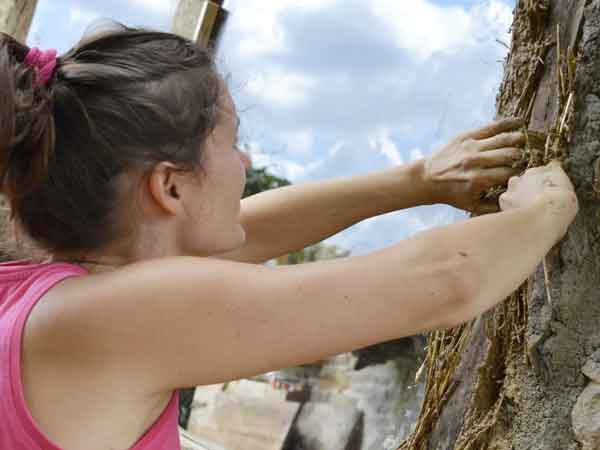Cob is one of the oldest building materials in the world.
A deceptively simple mixture of clay, subsoil, sand and straw, cob is formed when these ingredients are mixed together with water, either by hand or with machinery. During the mixing process, cob becomes a pliable material which can be formed into blocks and bricks, or laid as mass cob and built in stages (lifts).
In homes, cob blocks can be hollowed out to create extra space and storage. Cob can be curved into archways and easily moulded around windows and door frames. It is so versatile that it can be cleverly modelled into long-lasting sculptures and statues to decorate homes and gardens.
An eco-friendly alternative
Using the natural raw materials, cob is created from products within the earth and from products grown upon the earth’s surface. Cob is the ideal choice if you wish to build a natural habitat, especially if you own a plot of land and use the products of the land to build your home. If you are building a house with cob it will be unique. If you are building your own home, there will be a certain sense of satisfaction that you have created and installed every cob block yourself.
Cob is renowned for being a great insulator for sound and for heat. One of the reasons cob is so popular is due to its density, which creates the sound insulation. Cob is also energy efficient and the reason for this is because cob is capable of storing heat for long periods of time. Cob absorbs the heat from the atmosphere during the day and slowly releases the heat overnight. When the air temperature gets cooler the heat is released from the cob. This clever method of storing and releasing heat gives a house a steady temperature and reduces the need for central heating.
Weatherproofing cob buildings with lime
Cob is naturally durable and can withstand many extreme weather conditions. Many cob buildings have an external overhang of a thatch roof, perhaps half a metre or more. This obviously helps deflect the worst of the weather, however wind driven rain can penetrate even the most hardy of walls over a prolonged period of time.
If rainwater and moisture continually permeate the cob blocks then erosion can occur, especially on the corners of the barn or building which can bear the brunt of the worst storms, wind, rain and snow. This is where lime mortar is traditionally used to coat the outside of the cob and then coated in lime wash which protects the cob from the elements. Many people choose white or cream for the colour when lime washing the outside of their cob houses. However today, we have a larger range of colours available.
Choosing the best materials
To build a house, or barn, animal pen, or even a small oven for your garden, requires skill, time and patience. The larger the construction the more materials you will need and when building any type of cob structure, choosing the best materials will pay off in the long run. There’s no point building a house only for it to have cavities, instability or even collapse, just because the wrong materials were selected in the beginning.
When choosing the clay, it is important to check the sub-soil has a mixture of coarse stones, fine gravel and silt, which will add to the binding strength of the cob blocks. Also, choosing the right straw is an important consideration and barley is preferred because of its strength. Barley is non-brittle and can be grown more quickly than other crops to replenish the stock if you intend to build properties frequently.
The ratio of components is also important and a popular mixture to ensure a useable and effective cob is to use four parts of subsoil with three parts of straw and one part of water. The subsoil should be tested for compatibility before using. Too much clay or silt will produce a poor cob.
These can be mixed by hand or by machine and in the past cob would have been mixed by animals walking up and down on the layers of earth and straw until it formed the right density for using to build solid structures.
An ancient technique with a modern touch
Building with cob may have been around for many, many centuries, but that doesn't mean cob doesn’t have a place in today’s world. The oldest known cob structure is over 10,000 years old. It is still standing but is likely to have endured because it has been looked after by generations of people. Like all structures, cob buildings need care and attention from time to time. Simple checking for erosion and repairing damage before it becomes a problem is key to the longevity of cob buildings. A fresh coat of lime wash to renew the weatherproofing and protection every so often will extend the life of the cob as well.
Cob buildings have evolved over time and are inhabited by people of all ages. A building once lit by candlelight can now have electricity, solar power, running water and the Internet. All modern conveniences can be installed into a state-of-the-art kitchen, comfortable living areas and productive workspaces. At the end of the day, the sanctuary of a bedroom which is warm from the heat retention in the cob walls will provide somewhere cosy and safe to sleep at night.
www.heritagecobandlime.com
Time and date
CONSTRUCTION DIRECTORY
Construction News
23/01/2024
Why Ancient Cob Will Always Have A Place In Our Modern World

Latest Construction News
15/11/2024
A significant redevelopment is underway at Royal Naval Air Station (RNAS) Culdrose, Cornwall, following a contract award to Kier and Mott MacDonald. The Defence Infrastructure Organisation (DIO) and the Royal Navy marked the occasion with a contract-signing and ground-breaking ceremony, ...
15/11/2024
JV North, a consortium of housing associations and local authorities, has unveiled a new £500 million procurement framework aimed at delivering over 3,000 affordable homes between 2025 and 2029. The initiative marks a significant boost for social housing and the construction sector. The ...
15/11/2024
Sempra Homes has announced funding approval for a new affordable housing project at Bowers Close on London Road, Pitsea. The development will deliver 31 high-quality homes, offering a mix of rental and shared ownership properties designed to address local housing needs. The project has received ...
15/11/2024
Vistry Group has received planning permission for the first phase of its Wolborough Grange development, which will deliver 94 high-quality homes. This milestone marks the beginning of a transformative project that will provide sustainable housing and significant community benefits in Newton ...
15/11/2024
Salisbury Coach Park and the main footpaths through the Central Car Park have reopened following an extensive transformation by the Environment Agency as part of the River Park scheme. The upgraded facilities aim to provide a more welcoming and comfortable experience for coach passengers visiting ...
15/11/2024
Pennyfarthing Homes has unveiled an exceptional collection of one- and two-bedroom apartments at Oakwood Grove, a modern development offering affordable homes through the Government-backed First Homes scheme, now available via Dorset Council. Located in the scenic rural village of Alderholt, ...
15/11/2024
Morris & Spottiswood Group has acquired part of the collapsed ISG group, offering a vital lifeline to the employees and projects operating within its remit. Absorbing the former ISG Cathedral business, Morris & Spottiswood Group, which is a specialist provider of fitout, refurbishment, M&E, ...
15/11/2024
Morgan Sindall Construction has officially commenced work on Rosherville Church of England Academy, a new primary school designed to address the educational needs of Northfleet’s expanding community. To commemorate the start of the project, a time capsule was ceremonially lowered into the ground, ...
15/11/2024
Vistry Group has exchanged contracts to develop over 200 mixed-tenure homes at Waggons Way, Doncaster. The 16-acre site, formerly part of the Hatfield Colliery, will be transformed into a vibrant new community featuring up to 236 high-quality homes. The proposed development will include homes ...
15/11/2024
The University of Sunderland has officially relaunched its newly refurbished cinema. The venue on St. Peter's Campus was damaged beyond use due to Storm Arwen in 2021, but now a £1.3m investment means it is back in action once again. To mark the occasion, Sir David Bell, the University’s ...

















